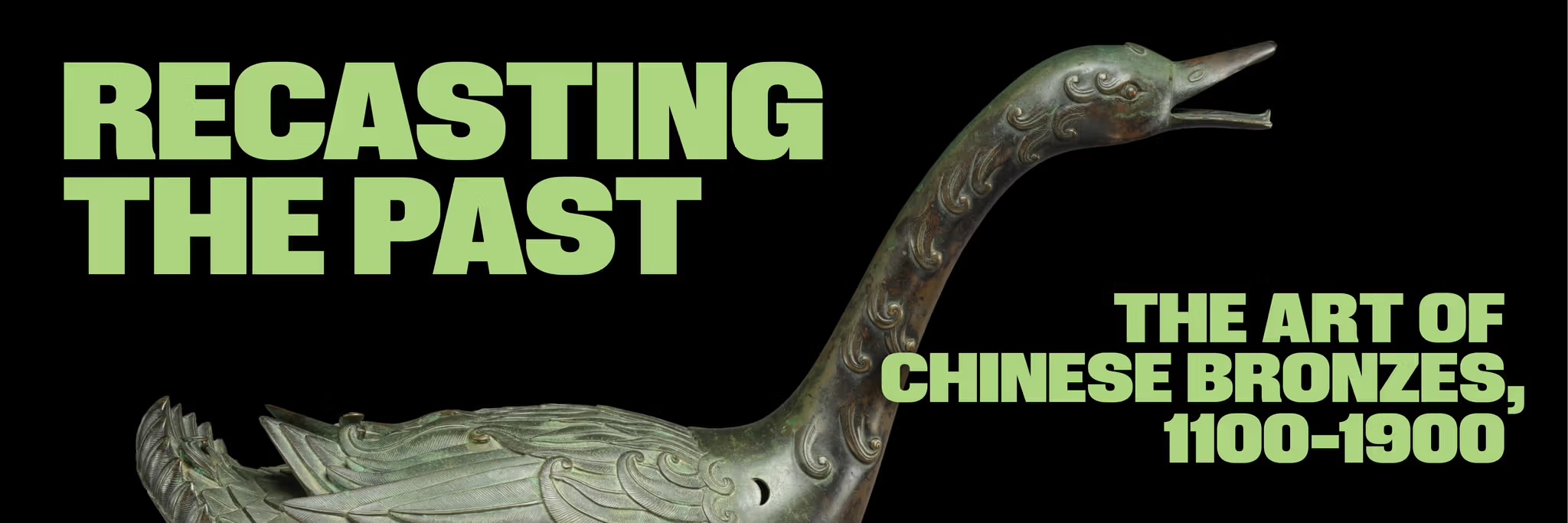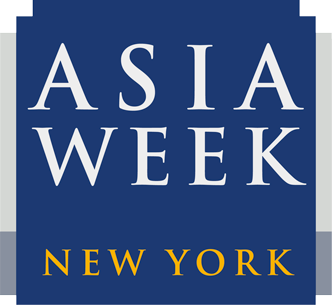ASIA WEEK NEW YORK EXHIBITION

Incense burner in the form of a goose, China, Ming dynasty (1368–1644), early 15th century. Bronze. The Metropolitan Museum of Art, New York, Purchase, The Vincent Astor Foundation Gift, 2020
Recasting the Past: The Art of Chinese Bronzes, 1100–1900
February 28 – September 28, 2025
Curator Talk: Tuesday, March 11, 11 am–12 pm
Galleries 209–218
Chinese bronzes made from the 12th to the 19th century are an important but often overlooked category of Chinese art. In ancient China, bronze vessels were emblems of ritual and power. A millennium later, in the period from 1100 to 1900, such vessels were rediscovered as embodiments of a long-lost golden age that was worthy of study and emulation. This “return to the past” (fugu) was part of a widespread phenomenon across all the arts to reclaim the virtues of a classical tradition. An important aspect of this phenomenon was the revival of bronze casting as a major art form. While archaic bronzes were used as containers for food or wine, these so-called “later bronzes” adapted antique shapes and decorative motifs to serve new functions as incense burners, flower vases, and all types of scholar objects. Later Chinese bronzes, however, have long been stigmatized as poor imitations of ancient bronzes rather than being seen as fundamentally new creations with their own aesthetic and functional character.
From important bronzes to a complementary selection of works including painting, calligraphy, ceramics, lacquers, and jades, the exhibition draws on an international array of loans to redress the previous misunderstanding of later Chinese bronzes. Some 100 pieces from The Met collection will be augmented by nearly 100 loans from major institutions in China, Japan, Korea, Germany, France, the United Kingdom, and the United States to present the most comprehensive narrative of the ongoing importance of bronzes as an art medium throughout China’s long history.
Be sure to sign up for their talk, Beyond Emulation: Rethinking Chinese Archaistic Bronzes, 1100–1900, on March 11 with curator Pengliang Lu to explore the overlooked roles of so-called “later Chinese bronzes” from the 12th to 19th century. These essential works have long been stigmatized as imitations of ancient bronzes, the ultimate emblems of ritual legitimacy, rather than as fundamentally new creations with their own aesthetic and functional character. Learn more about the misunderstanding surrounding these bronzes and celebrate their artistic and cultural significance. To learn more and RVSP click here.
The exhibition is made possible by the Florence and Herbert Irving Fund for Asian Art Exhibitions and the Joseph Hotung Fund.
To learn more and view related talks and programs, click here.
PAST ANNUAL DISTINGUISHED LECTURE
Annual Distinguished Lecture on the Arts of South and Southeast Asia—Sri Lanka and the Re-discovery of Knowledge: A.K. Coomaraswamy’s Medieval Sinhalese Art
Friday, March 14, 2025 from 6-7pm
The Grace Rainey Rogers Auditorium
Join us to learn how the eminent art historian A.K. Coomaraswamy, through his vast study of Sri Lankan ornament, art, and aesthetics, challenged the division between fine arts and crafts. Discover how Coomaraswamy developed a pioneering perspective that had a lasting impact on twentieth-century South Asian art history and beyond.
This lecture is made possible by the generous support of Jeff Soref and Paul Lombardi.
Free with Museum admission, though advance registration is recommended. Note: Space is limited; first come, first served. Priority will be given to those who register.
To learn more and register, click here.
ONGOING EXHIBITIONS
Embracing Color: Enamel in Chinese Decorative Arts, 1300-1900
Through January 4, 2026
Enamel decoration is a significant element of Chinese decorative arts that has long been overlooked. This exhibition reveals the aesthetic, technical, and cultural achievement of Chinese enamel wares by demonstrating the transformative role of enamel during the Ming (1368–1644) and Qing (1644–1911) dynasties. The first transformational moment occurred in the late 14th to 15th century, when the introduction of cloisonné enamel from the West, along with the development of porcelain with overglaze enamels, led to a shift away from a monochromatic palette to colorful works. The second transformation occurred in the late 17th to 18th century, when European enameling materials and techniques were brought to the Qing court and more subtle and varied color tones were developed on enamels applied over porcelain, metal, glass, and other mediums. In both moments, Chinese artists did not simply adopt or copy foreign techniques; they actively created new colors and styles that reflected their own taste. The more than 100 objects on view are drawn mainly from The Met collection.
Rotation 1: July 2, 2022–April 30, 2023
Rotation 2: May 20, 2023–March 24, 2024
Rotation 3: April 13, 2024–Feb 16, 2025
Rotation 4: March 1, 2025–Jan 4, 2026
A Passion for Jade: The Bishop Collection
Through January 4, 2026
More than a hundred remarkable objects from the Heber Bishop collection, including carvings of jade, the most esteemed stone in China, and many other hardstones, are on view in this focused presentation. The refined works represent the sophisticated art of Chinese gemstone carvers during the Qing dynasty (1644–1911) as well as the highly accomplished skills of Mogul Indian (1526–1857) craftsmen, which provided an exotic inspiration to their Chinese counterparts. Also on view are a set of Chinese stone-working tools and illustrations of jade workshops, which will introduce the traditional method of working jade.
 Marquee: Seated Ganesha, 14th–15th century. India (Orissa). Ivory, H. 7 1/4 in. (18.4 cm). The Metropolitan Museum of Art, New York. Gift of Mr. and Mrs. J. J. Klejman, 1964 (64.102)
Marquee: Seated Ganesha, 14th–15th century. India (Orissa). Ivory, H. 7 1/4 in. (18.4 cm). The Metropolitan Museum of Art, New York. Gift of Mr. and Mrs. J. J. Klejman, 1964 (64.102)
Ganesha: Lord of New Beginings
Through Janaury 4, 2026
Ganesha, the son of Shiva and Parvati, is a Brahmanical (Hindu) diety known to clear a path to the gods and remove obstacles in everyday life. He is loved by his devotees (bhakti) for his many traits, including his insatiable appetite for sweet cakes and his role as a dispenser of magic, surprise, and laughter. However, Ganesha is also the lord of ganas (nature deities) and can take on a fearsome aspect in this guise.
The seventh- to twenty-first-century works in this exhibition trace his depiction across the Indian subcontinent, the Himalayas, and Southeast Asia. Featuring 24 works across sculptures, paintings, musical instruments, ritual implements, and photography, the exhibition emphasizes the vitality and exuberance of Ganesha as the bringer of new beginnings.
Celebrating the Year of the Snake
Through February 10, 2026
The traditional East Asian lunar calendar consists of a repeating twelve-year cycle, with each year corresponding to one of the twelve animals in the Chinese zodiac. The association of these creatures with the Chinese calendar began in the third century BCE and became firmly established by the first century CE. The twelve animals are, in sequence: rat, ox, tiger, rabbit, dragon, snake, horse, ram, monkey, rooster, dog, and pig. Each is believed to embody certain traits that are manifested in the personalities of people born in that year. January 29, 2025, marks the beginning of the Year of the Snake, a creature characterized as alert, calm, and smart.
Celebrating the Year of the Snake presents a remarkable selection of works drawn from the Museum’s collection illustrating the significant role that the snake plays in Chinese culture, including a 3,000-year-old bronze ritual vessel with a spout formed by joined snakes’ heads, a 13th-century pottery figure of a mischievously smiling snake, and an 18th-century exquisitely painted porcelain cup portraying a scene from the “Legend of the White Snake,” a popular folktale of love and romance between humans and fantastic creatures.
The exhibition is made possible by the Joseph Hotung Fund. clouds and waves.
Colorful Korea: The Lea R. Sneider Collection
Through February 15, 2026
Over the course of forty years, Lea R. Sneider (1925–2020) formed a significant collection of Korean art that challenged established norms. While appreciating literati art, she was particularly drawn to lively and colorful forms connected to everyday life, resulting in a diverse collection that illustrates Korea’s vibrant material culture. This exhibition features a substantial gift and loans from the Lea R. Sneider Collection, generously provided by her children. Through approximately 100 pieces from the fifth century to the present, including paintings, ceramics, furniture, textiles, and funerary and ritual objects, the exhibition highlights the pervasiveness of auspicious symbolism and the unpretentious dynamism in Korean art. Sneider has said that the works reflect the vitality and warmth of the people who engaged with them, a sentiment that her collection, with its emphasis on cultural and everyday relevance, underscores.
The exhibition is made possible by the Ministry of Culture, Sports and Tourism of the Republic of Korea (MCST).
To view all exhibitions on view, click here.

